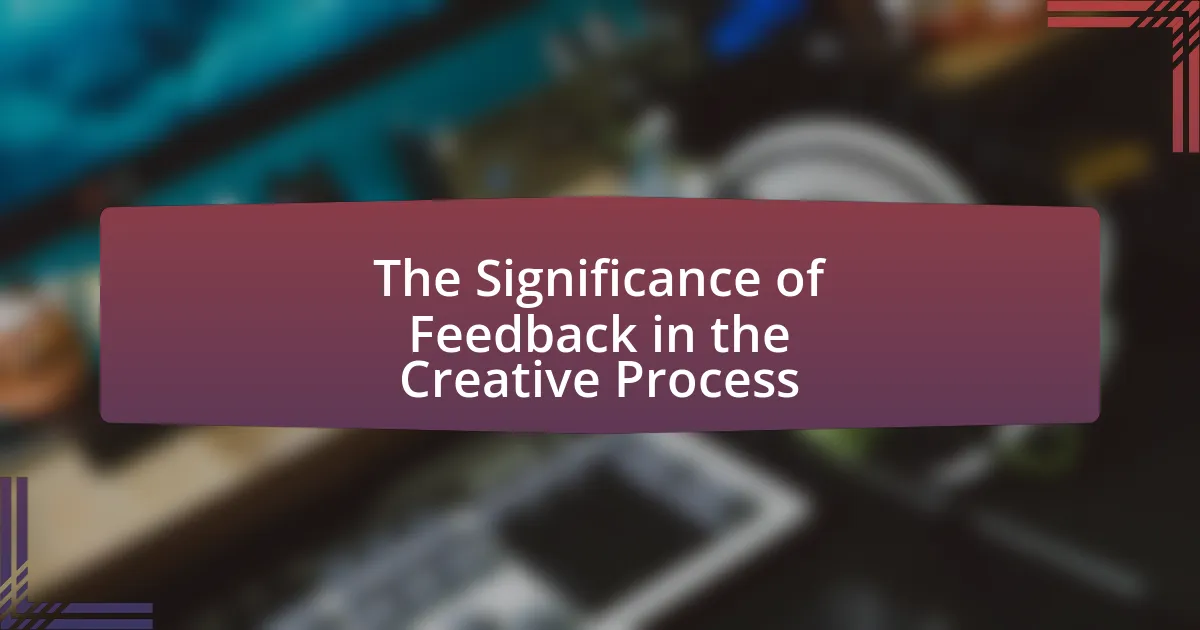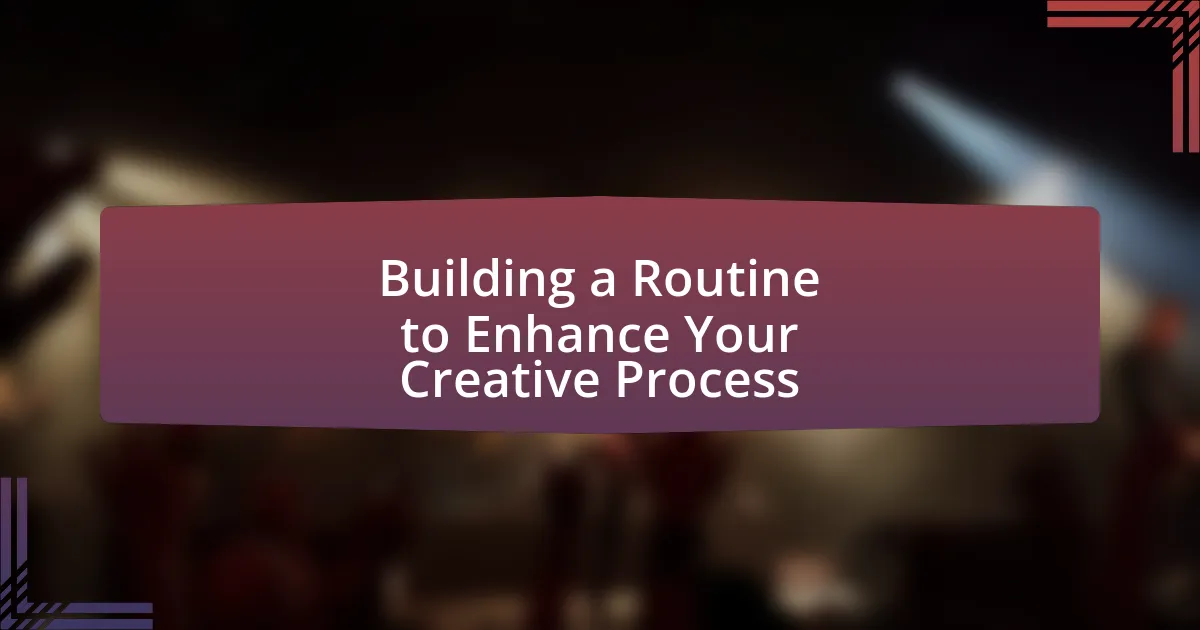The article examines the significant impact of the environment on a musician’s creative flow, highlighting how various factors such as physical space, social interactions, and emotional contexts influence creativity. It discusses the role of acoustics, lighting, and natural elements in enhancing or hindering creative expression, as well as the effects of different settings like studios, outdoor spaces, and home environments. Additionally, the article explores how social environments, collaborations, and audience interactions contribute to a musician’s creative process, while also addressing the importance of emotional states and personal experiences in shaping artistic output. Strategies for optimizing environments to foster creativity are also presented, emphasizing the need for structured routines and supportive social networks.
What is the Impact of Environment on a Musician’s Creative Flow?
The environment significantly influences a musician’s creative flow by shaping their emotional state, inspiration, and productivity. Factors such as acoustics, lighting, and even the presence of nature can enhance or hinder creativity. For instance, a study published in the Journal of Environmental Psychology found that natural environments can boost creative thinking and problem-solving abilities, suggesting that musicians may experience heightened creativity when surrounded by nature. Additionally, the physical space where musicians work, including its organization and aesthetic, can impact their motivation and focus, ultimately affecting their creative output.
How does the physical environment influence a musician’s creativity?
The physical environment significantly influences a musician’s creativity by shaping their emotional and cognitive responses. Factors such as acoustics, lighting, and spatial arrangement can enhance or hinder creative expression. For instance, a well-designed studio with optimal acoustics can inspire innovative sound exploration, while a cluttered or noisy space may lead to distraction and reduced focus. Research indicates that environments rich in natural light and greenery can boost mood and cognitive function, further facilitating creativity. A study published in the Journal of Environmental Psychology found that exposure to nature can enhance creative problem-solving abilities, demonstrating the direct link between physical surroundings and creative output.
What specific elements of the physical environment affect creative flow?
Specific elements of the physical environment that affect creative flow include lighting, noise levels, spatial arrangement, and temperature. Research indicates that natural light enhances mood and productivity, while excessive noise can disrupt concentration and hinder creativity. A well-organized and spacious environment promotes a sense of freedom and reduces distractions, facilitating creative thought. Additionally, optimal temperature, typically around 20-22 degrees Celsius, has been shown to enhance cognitive function and creativity. These factors collectively create an atmosphere conducive to creative flow, as supported by studies in environmental psychology.
How do different settings (studio, outdoor, home) impact creativity?
Different settings such as studio, outdoor, and home significantly impact creativity by influencing the mood, inspiration, and focus of musicians. Studios often provide a controlled environment with professional equipment, which can enhance technical creativity and productivity. Research indicates that structured environments can lead to higher output quality, as seen in a study by Kahn et al. (2018) published in the Journal of Creative Behavior, which found that musicians in studios produced more polished work compared to those in less structured settings.
Outdoor settings stimulate creativity through natural elements and changing scenery, which can inspire new ideas and emotional responses. A study by Kaplan and Kaplan (1989) in “The Experience of Nature: A Psychological Perspective” highlights that exposure to nature can enhance cognitive function and creativity by reducing mental fatigue.
Home environments offer comfort and familiarity, which can foster personal expression and emotional depth in creative work. However, distractions in home settings may hinder focus, as noted in research by Karpinski and Duberstein (2009) in the Journal of Educational Psychology, which found that home environments can lead to mixed results in productivity based on individual discipline.
In summary, the impact of different settings on creativity is multifaceted, with studios enhancing technical output, outdoor environments boosting inspiration, and home settings providing emotional comfort but potential distractions.
What role does social environment play in a musician’s creative process?
The social environment significantly influences a musician’s creative process by providing inspiration, collaboration opportunities, and emotional support. Musicians often draw from their interactions with peers, audiences, and cultural contexts, which can shape their artistic expression and innovation. For instance, studies have shown that collaborative environments, such as music groups or communities, enhance creativity by fostering idea exchange and diverse perspectives. Additionally, social settings can evoke emotional responses that inform songwriting and performance, as seen in genres like folk and blues, where personal and communal experiences are central to the music.
How do collaborations with other musicians enhance or hinder creativity?
Collaborations with other musicians enhance creativity by introducing diverse perspectives and skills, which can lead to innovative ideas and unique soundscapes. For instance, a study published in the Journal of Creative Behavior found that collaborative environments often stimulate creative thinking by allowing musicians to share techniques and influences, resulting in richer musical compositions. Conversely, collaborations can hinder creativity if conflicting artistic visions or egos clash, leading to a lack of cohesion in the creative process. Research from the University of California, Berkeley, indicates that when musicians do not align on creative goals, it can stifle individual expression and limit the overall creative output.
What is the effect of audience interaction on a musician’s creative flow?
Audience interaction significantly enhances a musician’s creative flow by providing immediate feedback and emotional connection. This interaction can stimulate inspiration, leading to spontaneous creativity and improvisation during performances. Research indicates that musicians often experience heightened motivation and engagement when they perceive their audience’s reactions, which can result in more dynamic and innovative musical expressions. For instance, a study published in the journal “Psychology of Music” by authors such as Hargreaves and North found that live audience responses can influence a musician’s performance style and emotional delivery, thereby directly impacting their creative output.
How does emotional environment affect a musician’s creativity?
The emotional environment significantly influences a musician’s creativity by shaping their emotional state, which directly impacts their artistic expression. Positive emotional environments, characterized by support and inspiration, can enhance creativity by fostering feelings of joy and motivation, leading to more innovative musical ideas. Conversely, negative emotional environments, marked by stress or conflict, can hinder creativity by inducing anxiety and self-doubt, which restricts the flow of ideas. Research by Silvia and Nusbaum (2011) in “Creativity Research Journal” indicates that emotional experiences can enhance creative problem-solving, demonstrating that a supportive emotional context can lead to higher levels of creative output in musicians.
What emotional states are conducive to creative flow in musicians?
Positive emotional states such as joy, excitement, and curiosity are conducive to creative flow in musicians. These emotions enhance motivation and engagement, allowing musicians to immerse themselves fully in their creative processes. Research indicates that positive affect can lead to increased cognitive flexibility and openness to new ideas, which are essential for creativity. For instance, a study by Isen (2002) found that individuals experiencing positive emotions are more likely to generate creative solutions and engage in divergent thinking, which is crucial for musical innovation.
How do personal experiences and mental health influence creativity?
Personal experiences and mental health significantly influence creativity by shaping an individual’s emotional state and cognitive processes. Positive personal experiences can enhance creativity by providing inspiration and motivation, while negative experiences, such as trauma or stress, can either hinder or fuel creative expression, depending on the individual’s coping mechanisms. Research indicates that individuals with mental health conditions, such as depression or anxiety, often exhibit heightened creativity, as their unique perspectives can lead to innovative ideas. A study published in the Journal of Creative Behavior found that artists frequently draw from their emotional struggles to create impactful work, demonstrating the complex relationship between mental health and creative output.
What are the connections between environment and musical genres?
The connections between environment and musical genres are significant, as the physical, cultural, and social contexts in which music is created influence its style and characteristics. For instance, genres like blues and jazz emerged from the African American experience in the Southern United States, reflecting the historical and social conditions of that environment. Similarly, reggae music developed in Jamaica, shaped by the island’s cultural heritage and socio-political issues. Furthermore, geographical elements, such as urban versus rural settings, can lead to distinct musical expressions; urban environments often foster genres like hip-hop, which are rooted in the experiences of city life. These connections illustrate how environmental factors directly impact the development and evolution of musical genres.
How do cultural environments shape the creative output of musicians?
Cultural environments significantly shape the creative output of musicians by influencing their artistic expression, themes, and styles. For instance, musicians often draw inspiration from the cultural narratives, traditions, and social issues prevalent in their surroundings, which can lead to the creation of music that resonates with specific audiences. Research indicates that musicians from diverse cultural backgrounds incorporate unique elements from their heritage, such as traditional instruments or local musical scales, into their work, thereby enriching their creative output. A study by the University of California found that musicians who engage with their cultural roots tend to produce more innovative and authentic music, demonstrating the profound impact of cultural context on artistic creativity.
What genres are most influenced by their environmental contexts?
Genres most influenced by their environmental contexts include folk, blues, and reggae. Folk music often reflects the cultural and geographical backgrounds of its creators, incorporating local stories and traditions. Blues originated in the Deep South of the United States, shaped by the African American experience and the socio-economic conditions of the region. Reggae, rooted in Jamaica, is heavily influenced by the island’s social issues, history, and Rastafarian culture. Each of these genres demonstrates a direct connection between the artist’s environment and their musical expression, showcasing how local contexts can shape artistic output.
How can musicians optimize their environment for better creative flow?
Musicians can optimize their environment for better creative flow by creating a dedicated, clutter-free workspace that minimizes distractions. A study published in the Journal of Environmental Psychology indicates that a well-organized and personalized space can enhance focus and creativity. Additionally, incorporating elements such as natural light, comfortable seating, and soundproofing can further improve the creative process. Research shows that exposure to natural light increases productivity and mood, while soundproofing helps eliminate auditory distractions, allowing musicians to immerse themselves fully in their work.
What practical changes can musicians make to their physical space?
Musicians can enhance their physical space by optimizing acoustics, organizing instruments, and creating a dedicated workspace. Improving acoustics can involve adding sound-absorbing materials like carpets or acoustic panels, which can reduce unwanted noise and enhance sound quality. Organizing instruments ensures easy access and minimizes distractions, allowing musicians to focus on their creative process. Establishing a dedicated workspace, free from clutter and interruptions, fosters a conducive environment for creativity. Research indicates that a well-structured environment can significantly influence a musician’s productivity and creative flow, as noted in studies on workspace design and its effects on performance.
How can musicians cultivate a supportive social and emotional environment?
Musicians can cultivate a supportive social and emotional environment by actively engaging in open communication and fostering collaboration within their communities. This approach encourages sharing experiences and emotional support, which are essential for mental well-being. Research indicates that social support significantly enhances creativity; for instance, a study published in the Journal of Creative Behavior found that musicians who collaborate with peers report higher levels of creative output and satisfaction. By creating spaces for regular interaction, such as jam sessions or workshops, musicians can strengthen their networks and build a foundation of trust and encouragement, ultimately enhancing their creative flow.
What strategies can musicians use to overcome environmental challenges to creativity?
Musicians can overcome environmental challenges to creativity by creating structured routines, utilizing technology for remote collaboration, and establishing dedicated creative spaces. Structured routines help musicians maintain focus and discipline, which is essential in environments that may be distracting. For instance, setting specific times for practice and composition can enhance productivity.
Utilizing technology, such as digital audio workstations and online collaboration platforms, allows musicians to connect with others regardless of geographical barriers, thus fostering creativity even in less-than-ideal physical environments. A study by the Berklee College of Music found that musicians who engaged in online collaboration reported increased creative output and satisfaction.
Establishing dedicated creative spaces, whether at home or in a studio, can significantly reduce distractions and enhance focus. Research indicates that a well-organized and personalized workspace can lead to improved creativity and productivity. By implementing these strategies, musicians can effectively navigate and mitigate the environmental challenges that impact their creative flow.





